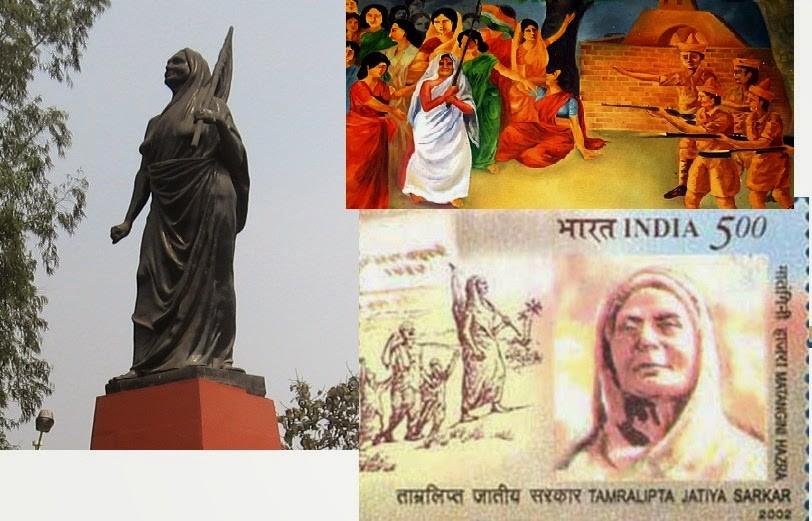led one procession from the north….even
after the firing commenced, she continued to advance with the tri-colour
flag, leaving all the volunteers behind…..The police shot her three
times. She continued marching despite wounds to the forehead and both
hands…..
We all luv Helly Luv. She is a Kurd who wants to “risk it all” and dedicate herself towards total freedom for the Kurd nation.
….
This reminds us that while there are mostly men on the front-lines of un-freedom around the world, there has been no dearth of proud women who have risked it all for total freedom.
….
On August 1942 (actually September) Gandhi gave the call for the British to Quit India. He also said that this time it is “karenge yeh marenge” (do or die). Matangini Hazra was already a well known freedom fighter. At 73 years of age she used to be lovingly called : Gandhi-Buri (old lady who is a Gandhi). On 29th September, 1942, Matangini marched at the head of a group of (unarmed) women to the Tamluk police station in Bengal and was shot dead point blank by the police. Gives a new meaning to “risk it all.”
We salute Helly Luv and we wish all the best to her and hope Kurdistan becomes a free nation that also does not compromise on freedom of its citizens. And we salute Matangini Hazra and all other women who died so that their fellow countrymen will live free.
……………….
Kurdish pop singer Helly Luv says she will not be put off by death
threats from Iraqi Islamist militants since release of her first music
video but, drawing on its title, insists she will ‘Risk It All’ to help a
push for an independent Kurdistan.
Iraqi-born Luv, 25, has seen
her video rack up more than 2.5 million views on YouTube since its
release in February; but she has faced criticism for what some see as
provocative imagery in the clip accompanying the modern mix of dance,
hip-hop and traditional Middle Eastern music.
Luv’s mother was a Kurdish ‘peshmerga’ fighter before the family emigrated during the Iran-Iraq War..…Luv recently visited Kurdish peshmerga forces that have been involved in skirmishes with the Islamic State. Photos
on her Facebook page show her wearing an old-style peshmerga uniform,
red and black scarf and aviator sunglasses, standing before ranks of
black-uniformed Kurdish troops.
By email she said she had been
close to Mosul, the Iraqi power base of the Islamic State, which lies
just 10 km from territory controlled by forces of the Kurdish Regional
Government.
“I wanted my first single to be ‘Risk It All’ to let people know that’s what I represent,” Luv said.
As
a baby, Luv spent nine months in a refugee camp in Turkey before her
family emigrated to Finland. She moved to Los Angeles at 18 to pursue a
music career and after struggling for several years was picked up by
LA-based independent label G2 Music.
…….
[ref. Wiki] Matangini Hazra’s ….was born in the small village of Hogla, near Tamluk in 1869, and that because she was the daughter of a poor peasant, she did not receive a formal education.. She was married early and became widowed at the age of eighteen without bearing any offspring.
….A notable feature of the freedom struggle in Midnapore was the participation of women. In 1932, she took part in the Non-Cooperation Movement and was arrested for breaking the Salt Act. She was promptly released, but protested for the abolition of the tax. Arrested again, she was incarcerated for six months at Baharampur. After being released, she became an active member of the Indian National Congress and took to spinning her own Khadi. In 1933, she attended the subdivisional Congress conference at Serampore and was injured in the ensuing baton charge by the police.
As part of the Quit India Movement, members of the Congress planned to take over the various police stations of Midnapore district and other government offices.
This was to be a step in overthrowing the British government in the
district and establishing an independent Indian state.
Matangini Hazra,
who was 73 years at the time, led a procession of six thousand
supporters, mostly women volunteers, with the purpose of taking over the
Tamluk police station. When the procession reached the outskirts of the town, they were ordered to disband under Section 144 of the Indian Penal Code by the Crown police.
As she stepped forward, Matangini Hazra was shot once. Apparently, she had stepped forward and appealed to the police not to open fire at the crowd.
The Biplabi newspaper of the parallel Tamluk National Government commented:
As she was repeatedly shot, she kept chanting Vande Mataram, “hail to the Motherland”. She died with the flag of the Indian National Congress held high and still flying.
The parallel Tamluk government incited open rebellion by praising her
“martyrdom for her country” and was able to function for two more
years, until it was disbanded in 1944, at Gandhi’s request.
….
India earned Independence in 1947 and numerous schools, colonies, and
streets were named after Matangini Hazra. The first statue of a woman
put up in Kolkata, in independent India, was Hazra’s in 1977. A statue now stands at the spot where she was killed in Tamluk. In 2002, as part of a series of postage stamps
commemorating sixty years of the Quit India Movement and the formation
of the Tamluk National Government, the Department of Posts of India
issued a five rupee postage stamp with Matangini Hazra’s likeness. Hazra Road in South Kolkata is named after her.
……….
Link: http://www.dawn.com/news/1119499/kurdish-pop-star-ready-to-risk-it-all-for-independence/
……..
regards


